What is True RMS?
True RMS measurement is more reliable and accurate than RMS measurement. We express the AC voltage and current in its effective or RMS value. RMS Value of alternating voltage or current is equal to the square root of the average of the square of AC current or voltage value over a period of time.
The RMS measurement is accurate if the waveform is perfectly sinusoidal. However, nowadays, most of the loads are non-linear loads, and the voltage or current waveform is not perfectly sinusoidal. In this case, the true RMS measurement is the most suitable for distorted and non-distorted waveform measurement.
The RMS meter measures the peak value.
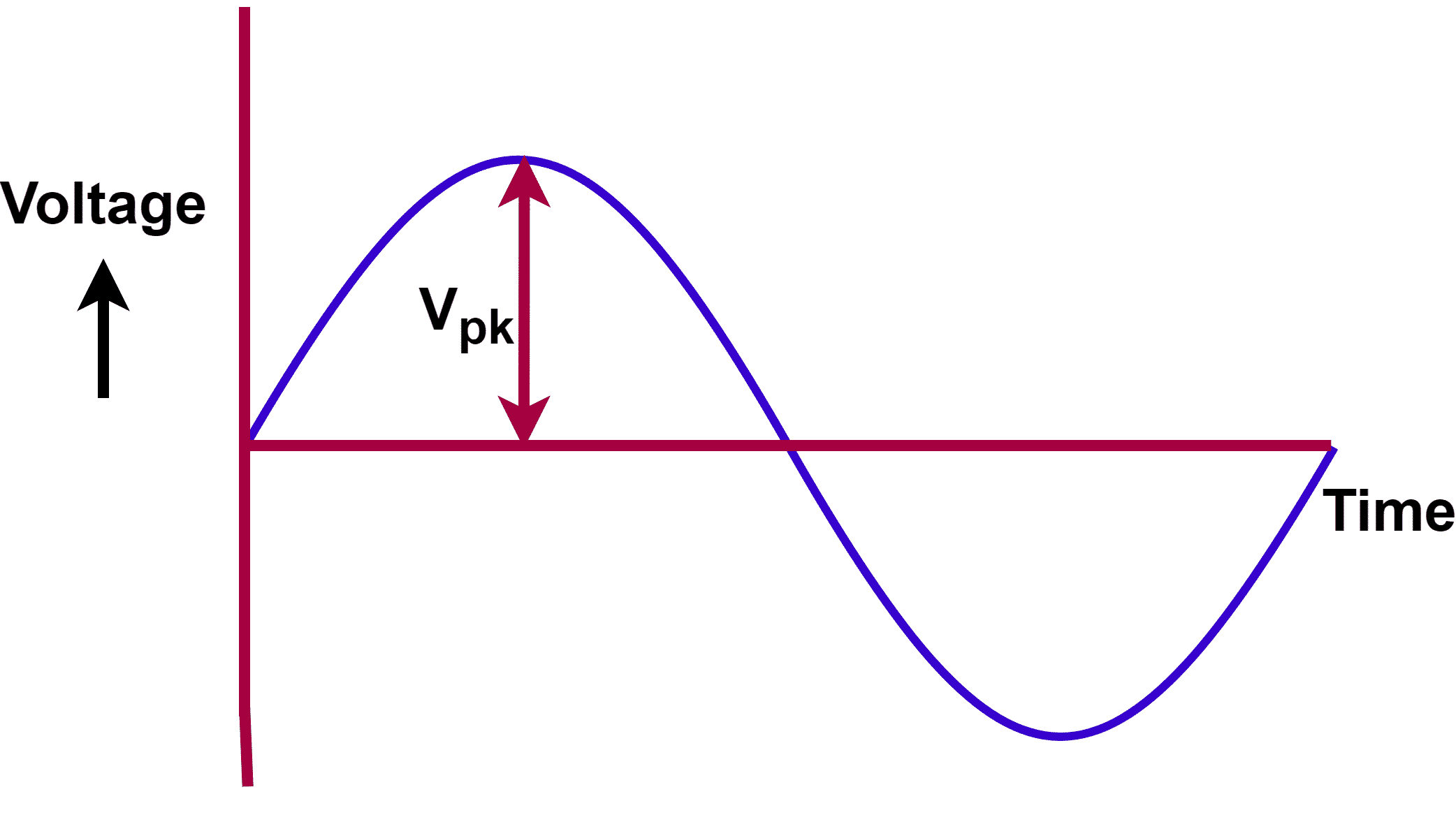
Then, the meter calculates the RMS value. The formula of the RMS value of sinusoidal voltage is given below.
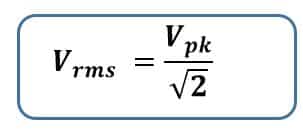
Let us understand why the true RMS meter is accurate. On the other hand, why is average responding or RMS measuring voltmeter or ampere meter less accurate?
What is the difference between RMS and True RMS?
The meter that uses the averaging technique to calculate the RMS value of voltage or current is called an RMS measurement. The RMS value of the AC current or voltage has the same heating effect that is equal to the heating effect of the DC current or voltage of the same magnitude.
We express the alternating voltage or current for its effective values. The square root of the average square of alternating voltage or current is called the RMS value. The ratio of RMS to the average value for a perfectly sinusoidal waveform is 1.11. The RMS value is equal to 1.11 times the average value.
For a perfect sinusoidal voltage waveform, the peak value is 1.414 times the RMS value or 0.707 times the peak value. Thus, the average responding meter gives the RMS measurement correctly for a pure sinusoidal waveform.
The measurement’s accuracy depends on the perfection of the sinusoidal waveform. Measuring the distorted waveform with an RMS meter will produce an enormous error.
The true RMS meter calculates the heating effect of the current/voltage waveform by sampling the waveform. The True RMS meter has a high sampling rate. The several samples for a waveform give the exact heating effect. Thus, the true RMS meter is the most accurate for measuring distorted current/voltage waveform.
Why True RMS measurement more accurate?
The meter uses a more complex mathematical formula for calculating the RMS value of the waveform. Therefore, the meter takes more measurement samples in one cycle to get the exact value of the current/voltage waveform.
True RMS Formula
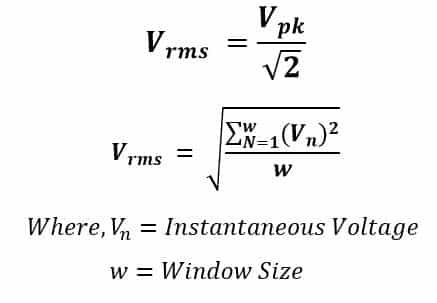
True RMS Calculation
For example, the true RMS voltage of the window size of 100 is equal to the square root of each voltage of the 100 instantaneous voltages squared divided by 100.
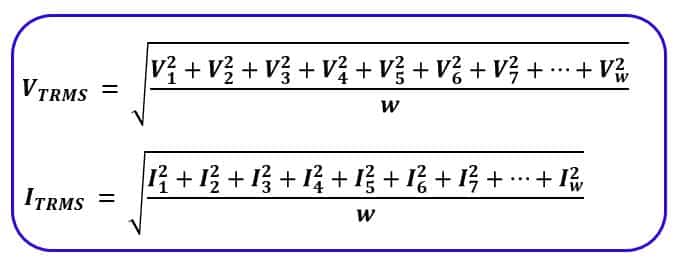
The more the number of samples, the more accurate the measurement. The meter takes into account the current spikes, noise, and distortion, therefore it gives the correct measurement.
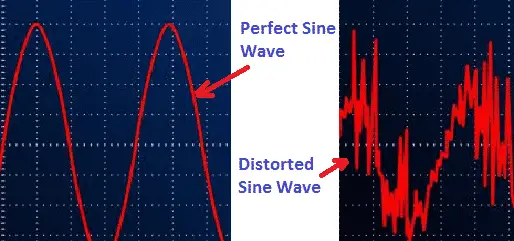
True RMS and RMS meters read correctly the perfectly sinusoidal waveform
The average responding meter can measure the voltage and current. The average responding meters give accurate readings for linear loads. The linear loads are heaters, induction motors, and incandescent lamps. The linear load draws current in phase with the applied voltage. Therefore, the current drawn by non-linear loads increases in proportion to the voltage. In other words, the current drawn by linear loads is sinusoidal. In the case of linear loads, both true RMS and average responding meter can be used to measure voltage or current.
True RMS reads correctly the non-sinusoidal waveform, the RMS meter reads with an error
The average responding meter reads low. We use a true RMS meter to read the current of non-linear loads. The non-linear loads are the DC Drive, variable frequency drive, and electronic equipment. Semiconductor devices like a diode, SCR, and IGBT have non-linear characteristics. The current drawn by these devices is not linear to the applied voltage, and because of this, the current waveform is distorted.
The semiconductor devices produce harmonic current in the electrical network. The average responding meter can not measure the non-sinusoidal current accurately. Therefore, non-linear loads need a true RMS meter for measuring current and voltage.
If the meter is labeled and specified to respond to the true RMS value of the current. It means the meter’s internal circuit calculates the heating value of the current or voltage. This method gives accurate measurement irrespective of the current wave shape.
The true RMS meter reads correctly for all types of wave shapes, whether sine waves, square waves, triangular waves, etc. If we use the average responding meter, the reading errors of different wave shapes are given below.

Where to measure the True RMS value?
If the voltage or current waveform is perfectly sinusoidal, the true RMS and average responding meter read accurately. In recent years, non-sinusoidal current devices have been popularly used. The recently developed devices are as follows.
- Variable frequency drives(VFDs)
- DC drives
- Electronic ballast
- HVAC
- Solid-state contactors
In these devices, the current flows in spikes rather than having a perfect sinusoidal waveform. The current wave shapes have a dramatic effect on the measurement. If an average responding meter is used for measurement, then the appreciable amount of measurement error will be there.
True RMS instruments are much more accurate than RMS instruments when measuring distorted waveforms or waveforms deviating from sinusoidal waveshapes.
Specifications of True RMS Multimeter
4½ Digit True RMS Digital Multimeter
- DC Votage range: 200mV/2V/200V/1000V
- DC Voltage accuracy: +(1.0%+5)
- AC Voltage Range :2V/20V/200V/750V
- AC Voltage Accuracy: +(0.8%+25)
- DC Current Range:200uA/2mA/200mA/20A
- DC Current Accuracy: +(0.5%+4)
- AC Current Range: 200mA/20A
- Resistance:200ohm/2kohm/20kohm/200kohm/2Mohm/20Mohm
- Resistance Accuracy: +(0.4%+5)
- Capacitance Range:2nF/2uF/200uF
- Capacitance Accuracy: +(4.5%+50)
- Conductance Range: (0.1~100)nS
- Conductance Accuracy: +(1.0%+30)
- Frequency Range: 20kHz/200kHz
- Frequency Accuracy: +(1.5%+25)
- Input Impedance:10Mohm
- Sampling rate:2 times/sec
- AC Frequency response:40Hz to 400Hz
- True RMS
- AC Frequency response:40Hz to 400Hz
- Max.Display:19999
- Full function protection, anti-high voltage circuit design
- Low battery indication
- Continuity buzzer
- Auto power off
Read Next: